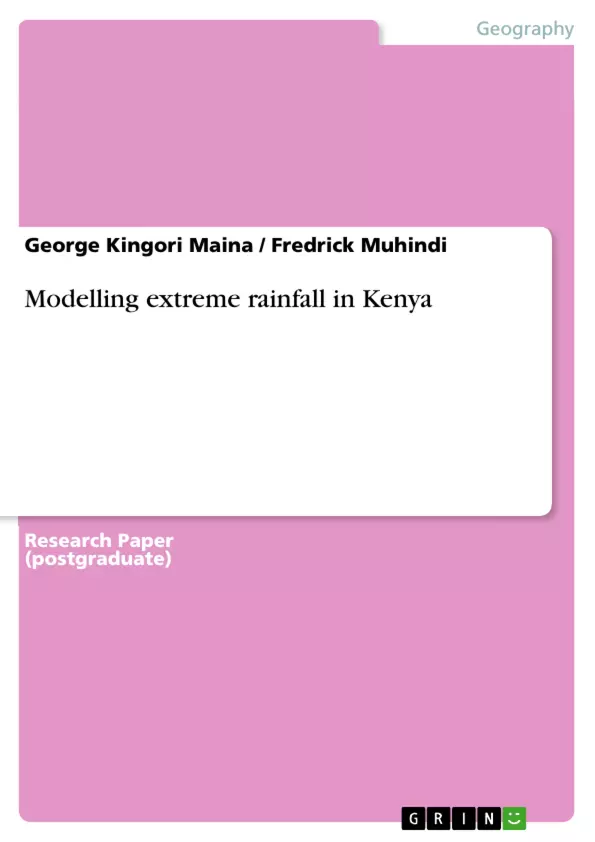Occurrence of extreme rainfall has increased globally for couple of years, causing a lot of damages that affect the aspects of life such as, economic, environmental, social and physical. Different researchers have used different methods to model extreme rainfall around the globe. For example Generalized Extreme Value (GEV) and time series. This project focuses on modelling extreme rainfall in the areas Nyeri, Kericho Mombasa Nairobi and Kakamega. There are areas which are more prone to heavy rains, using rainfall data for the past 20 years to model extreme rainfall pattern in Kenya. We have used generalized Pareto distribution (GPD) to model extreme rainfall and have used time series to show the pattern and forecast the occurrence of extreme rainfall in Kenya.
From forecasted result, we found that for the year 2016-2018 monthly rainfall tend to increase and decrease randomly this could be as a result of changes in climate due to global warming.
Inhaltsverzeichnis (Table of Contents)
- DEDICATION
- ACKNOWLEDGEMENT
- ABSTRACT
- LIST OF ABBREVIATIONS
- CHAPTER ONE
- INTRODUCTION
- 1.1 Background
- 1.2 Statement of the problem
- 1.3 Objectives
- 1.3.1 General objectives
- 1.3.2 Specific objectives
- 1.4 Scope of the study
- CHAPTER TWO
- LITERATURE REVIEW
- 2.0 Introduction
- 2.1 Related study
- CHAPTER THREE
- RESEARCH METHODOLOGY
- 3.1 Introduction
- 3.2 Data collection
- 3.3 Methodology
- 3.3.1 Fitting a GPD to the rainfall series
- 3.3.2 Estimation of parameters
- 3.3.3 Time series analysis
- 3.3.4 Auto-Regressive Model - AR (p)
- 3.3.5 Moving average model - MA (q)
- 3.3.6 Auto-regressive moving average model - ARMA (p, q)
- 3.3.7 Box-Jenkins Approach
- CHAPTER FOUR
- DATA ANALYSIS AND REPRESENTATION
- 4.1 Introduction
- 4.2 DESCRIPTIVE ANALYSIS
- 4.3 GENERALIZED PARETO DISTRIBUTION
- 4.3.1 Parameter estimation
- 4.3.2 Goodness of fit
- 4.4 RAINFALL TIME SERIES PLOT FOR DIFFERENT REGIONS IN KENYA
- 4.4.1 Stationarity and seasonality
- 4.4.2 Model identification
- 4.4.3 Identification of best fit ARIMA model
- CHAPTER FIVE
- SUMMARY OF FINDINGS, CONCLUSION AND RECOMMENDATION
- 5.1.1 Summary of findings
- 5.1.2 Conclusion
- 5.1.3 Recommendation
- References
Zielsetzung und Themenschwerpunkte (Objectives and Key Themes)
This study aims to model extreme rainfall patterns in five regions of Kenya using generalized Pareto distribution (GPD) and time series analysis. The project utilizes rainfall data from the past 20 years to identify and forecast potential occurrences of extreme rainfall events.
- Modeling extreme rainfall events in Kenya
- Utilizing generalized Pareto distribution (GPD) for modeling
- Employing time series analysis to forecast rainfall patterns
- Identifying and evaluating the best fit ARMA models for each region
- Analyzing the impact of climate change on rainfall patterns
Zusammenfassung der Kapitel (Chapter Summaries)
- Chapter One: Introduction: This chapter introduces the topic of extreme rainfall in Kenya and its impacts. It defines the problem, outlines the study's objectives, and specifies its scope.
- Chapter Two: Literature Review: This chapter explores existing research on extreme rainfall modeling techniques and relevant studies conducted in Kenya.
- Chapter Three: Research Methodology: This chapter details the data collection process, methodology used for analyzing the rainfall data, and explains the application of GPD and time series models.
- Chapter Four: Data Analysis and Representation: This chapter presents the results of the analysis, including descriptive statistics, parameter estimation for GPD, and the identification of best fit ARIMA models for each region.
Schlüsselwörter (Keywords)
This research focuses on extreme rainfall modeling, generalized Pareto distribution (GPD), time series analysis, ARMA models, climate change, Kenya, rainfall data, and forecasting.
- Quote paper
- MSC George Kingori Maina (Author), Fredrick Muhindi (Author), 2022, Modelling extreme rainfall in Kenya, Munich, GRIN Verlag, https://www.grin.com/document/1223565



